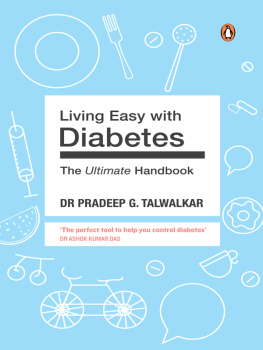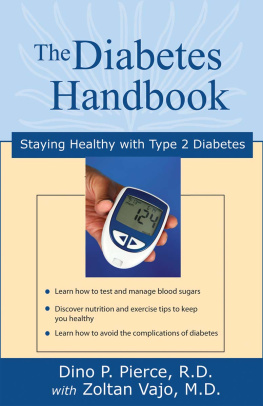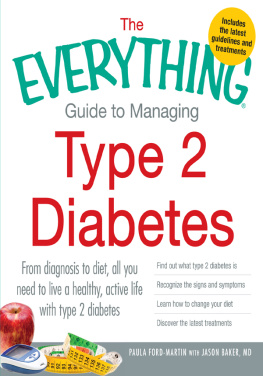Dr Pradeep G. Talwalkar has been practising diabetology for three decades now. Formerly a postgraduate teacher of internal medicine, he now teaches diabetology.
A sought-after speaker at various conferences, symposiums and continuing medical education programmes, Dr Talwalkar has lectured extensively all over India. He is very active on the patient education front: besides conducting workshops and seminars, he uses the print, radio, television and online media to spread awareness about diabetes among patients and caregivers.
Dr Talwalkar has attended numerous international conferences on diabetes and visited several centres of excellence in the field. He has actively participated in all conferences of the International Diabetes Federation since the 1988 conference in Sydney, Australia. He has authored over fifty papers in national and international journals, and written and edited books on diabetes for laypeople, family physicians and consultants. He is the assistant editor of API Textbook of Medicine (sixth edition), a popular textbook with wide readership in India.
PENGUIN BOOKS
UK | Canada | Ireland | Australia
New Zealand | India | South Africa
Penguin Books is part of the Penguin Random House group of companies whose addresses can be found at global.penguinrandomhouse.com.
This collection published 2013
Copyright Dr Pradeep G. Talwalkar, 2013
The moral right of the author has been asserted
Jacket images Pallavi Agarwala
ISBN: 978-0-143-41972-3
This digital edition published in 2013.
e-ISBN: 978-8-184-75986-0
This book is sold subject to the condition that it shall not, by way of trade or otherwise, be lent, resold, hired out, or otherwise circulated without the publishers prior consent in any form of binding or cover other than that in which it is published and without a similar condition including this condition being imposed on the subsequent purchaser.
I am deeply indebted to my patients for
listening to me and giving me the opportunity
to hone my skills in patient education.
I dedicate this book to all my patients.
Introduction
I have been practising as a diabetologist for about three decades. Early in my career, I realized that many of my patients with diabetesand these included those that had been diabetic for a long time as well as those who were highly educatedwere not at all knowledgeable about or clued-up on the nitty-gritty of diabetes. In other words, they were diabetes illiterate. Moreover, they had numerous misconceptions about diabetes. This, in my opinion, is a major obstacle on the path to achieving persistently good blood glucose control and thus preventing or significantly postponing the dreaded complications of diabetes and leading a healthy and high quality life.
I sincerely believe that a diabetes illiterate patient reflects poorly on the ability of his treating physician. Educating and sensitizing the patient is an integral part of the overall management of diabetes. If a patient does not understand the importance of constant monitoring and regular treatment, he will never totally comply with the doctors advice and, as a result, will struggle to achieve blood glucose control.
There has been tremendous activity in the field of diabetes research and management in the last few years. And yet there is no sign of a decline in the epidemic of diabetes. As per a to 126 mg% because some patients have been diagnosed with diabetic retinopathy (an eye complication specific to diabetes) at blood glucose levels lower than 140 mg%. In fact, the lowest fasting blood glucose level at which diabetic retinopathy has been documented is 126 mg%. The higher limit for normal fasting blood glucose has also been reduced from 110 mg% to 100 mg%.
There have been some changes in the classification of diabetes as well. The science of diabetology has evolved (not at the rate we would have liked it to, though) and we now know more about diabetes than ever before. In the last few years, several new anti-diabetic pills and injections have been introduced in India. Diabetics and those interested to know more about it would naturally like to keep pace with these new developments. It is essential for a diabetic to acquire working knowledge of various aspects of diabetes. Knowledge is one of the four pillars on which successful management of diabetes rests. This has motivated me to write this simple yet comprehensive book for patients with diabetes and pre-diabetes and others, such as caregivers, who want to learn more about it.
Living Easy with Diabetes is essentially a handbook, written in simple and easy language, with the sincere aim of educating diabetics and their close relatives and friends who are involved in caring for them on a daily basis. The idea is to provide the readers with important information on various aspects of diabetesinformation that should be complementary to the medical advice provided by the treating physician or diabetologist. Diabetes is a lifelong disease and therefore requires lifelong commitment from diabetics.
Diabetes is also a silent disease. Typical symptoms of diabetes develop only after a patients blood glucose shoots up to a very high level, say greater than 400 mg%. (Please note that the acceptable blood glucose levels are 70 mg%130 mg% for pre-meal blood glucose and under 180 mg% for post-meal blood glucose, as benchmarked by the American Diabetes Association.) Even mildly elevated blood glucose levels over long periods, a few months or years, are sufficient to cause significant damage to vital organs such as eyes, kidneys and heart. The danger is that during this phase of mild blood glucose elevation, patients do not exhibit any classic symptoms of diabetes and falsely believe that they must be doing well on the diabetes front. Pressing needs of day-to-day life take priority over medical check-ups. It is important to understand that no matter how good he or she feels, a diabetic must go for regular, periodic check-ups.
Consider the real-life case of forty-five-year-old Anand, an ambitious and hard-working businessman. Last year, Anand was deeply involved in the construction of a new factory to meet the growing market demand for his products. For six months, he almost forgot about his diabetes and neglected his exercise, diet and medication regimen. When his neighbour was diagnosed with gangrene brought on by uncontrolled diabetes, he remembered that he too was a diabetic and resolved to be sincere in following his diet, exercise and medication. He quickly underwent investigations to ensure that he was still free from complications of diabetes despite inadequate control over his blood glucose over the preceding six months. He thanked god that he had indeed escaped the complications, remembering another incident from two years ago when he had escaped unscathed from a high-speed car accident on the busy MumbaiPune expressway. Anand never forgets these two incidents, and thanks god profusely for letting him escape unharmed both times.
















